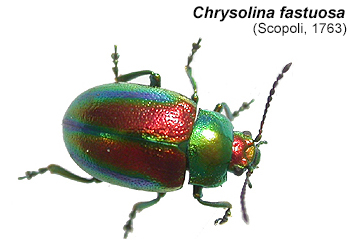Chrysolina americana (Linnaeus, 1758)  |
| This is a
stunning and beautiful beetle, showing a rainbow like
colouration when viewed closely, although at first
glance, this beetle appears dark brown. Chrysolina
americana is another invertebrate that has appeared
in the UK only relatively recently. Despite its Latin
name, this beetle does not originate from America, but
was originally a southern European species. It first
appeared in the UK in the 1990's and has steadily spread
north since. Nottinghamshire's first records seem to have
occurred in 2009 from sites in Nottingham and Newark.
This was a beetle we had looked for during the last few
years and our first record came when six adults were
found in the courtyard of the old Edwinstowe Craft
Centre, now home to the Sherwood Forest Trust on
01/06/11. The adults are around 8-9mm and can potentially
be found on Rosemary, Lavender and other herbs. |
| ...... |
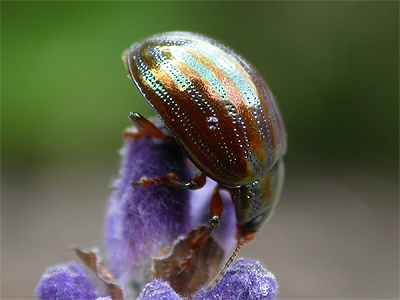 |
|
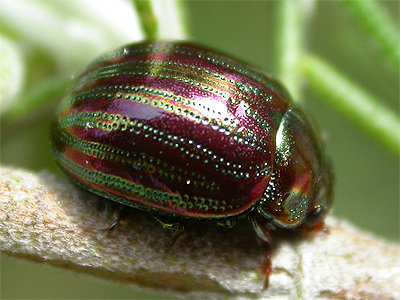 |
| |
|
|
| |
|
|
Chrysolina brunsvicensis
(Gravenhorst, 1807)  |
Chrysolina brunsvicensis has always proved to been historically rare
in Nottinghamshire, with records prior to 2021 from Attenborough in
1903 and Barrow Hill Wood in 1908. After much searching personally and
checking any Chrysolina hyperici found over recent years,
Chrysolina brunsvicensis was suddenly
found at
Blidworth Woods by David Shaw in October 2021. David then found it at Hangar Hill Plantation and
near Budby Pumping Station in November 2021 while I turned it up at Carburton Border
and then Clipstone Old Quarter.
Very similar to the
much commoner
Chrysolina hyperici (the two species have been found together
at at least one Nottinghamshire site) with differences in the puncturation being
the best indicator of species, but specimens showing a beautiful claret
colouration usually prove to be C. brunsvicensis. It seems to
prefer St John's Wort (Hypericum sp) growing along the sides of
forest tracks. |
| ...... |
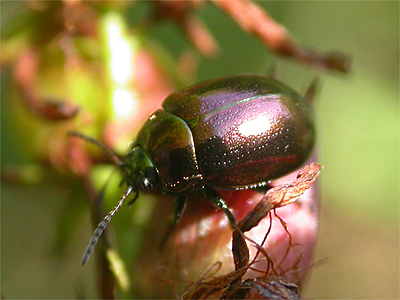 |
|
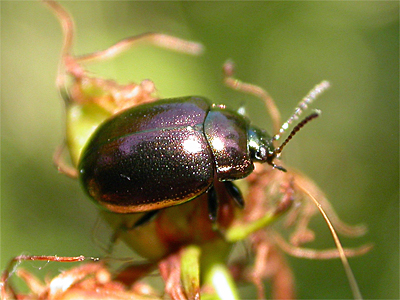 |
| |
|
|
| |
|
|
Chrysolina
fastuosa (Scopoli,
1763)  |
| Chrysolina
fastuosa is a stunning beetle and a species which,
despite some people telling us it's common, it
certainly does'nt seem to be. Despite knowing of one site
at Shelford in the Trent Valley where it can be found on
White Dead-nettle (Lamium album) we searched
everywhere we went for nearly two years, before finding
numerous adults on Common Hemp Nettle (Galeopsis
tetrahit) growing by the River
Meden in early July 2011. |
| ...... |
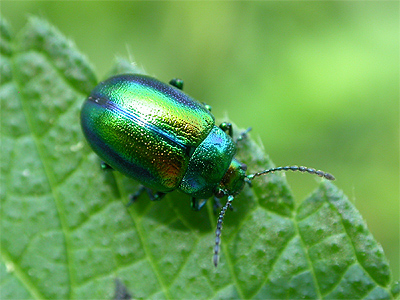 |
|
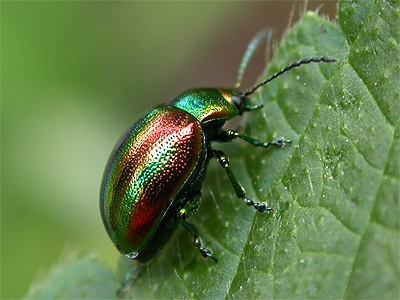 |
| |
|
|
| |
|
|
Chrysolina hyperici (Forster, 1771)  |
| A common UK
species, Chrysolina hyperici is a beautifully
coloured metallic beetle. The adults can be found
wherever St John's Wort (Hypericum sp)
grows, eating the flowers and resting amongst the flower
heads during the day. We have found adults at Warsop Main
Pit Top, Bevercotes Pit Wood, Gedling Pit Top, Sherwood
Forest CP, Clipstone Old Quarter and Budby South Forest
and it is generally very common where it occurs. Probably
most former colliery sites will host them. Length around
7mm. Historically, this beetle has been recorded from
South Leverton (Thornley) Barrow Hills, Everton (Chamberlin 1905) and Cuckney Hay Wood in 1914. |
| ...... |
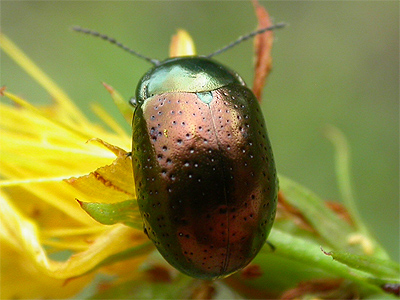 |
|
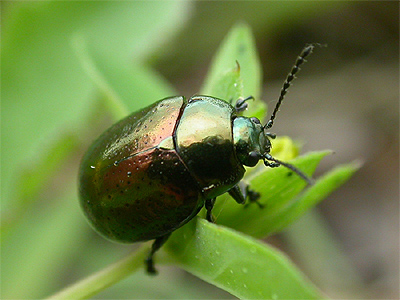 |
| |
|
|
| |
|
|
Chrysolina
marginata (Linnaeus, 1758)  |
| A rare leaf
beetle in Nottinghamshire, although accurate
determination of its true county and UK status, is made
more difficult through the nocturnal habits of this
species. Feeding on Yarrow (Achillia millefolium),
Chrysolina marginata is known to have occurred
on just one previous occasion in Nottinghamshire, when
found on the Nottinghamshire Wildlife Trust's Skylarks
Reserve at Holme Pierrepont in 2011. Our chance discovery
of this beetle at Warsop Main Pit Top in September 2014,
could mean that Chrysolina marginata is present
at other former colliery sites across the county. |
| ...... |
 |
|
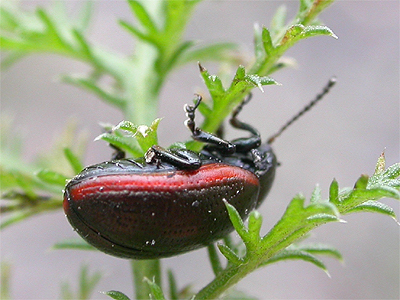 |
| |
|
|
| |
|
|
Chrysolina
oricalcia (Müller, O.F., 1776)  |
| Chrysolina
oricalcia seems to be a common species where it
occurs, but it is restricted in Nottinghamshire. We have
only found it occasionally at a few areas of Sherwood
Forest CP and at nearby Clipstone Old Quarter. Despite
being around 9mm in length, this is not always that easy
a species to spot on the stems of Cow Parsley. It seems
that like most Chrysolinas, the adults
over-winter (probably underneath loose bark or in leaf
litter) as we found an adult climbing the trunk of an
Oak, during a moth-trapping session at Sherwood Forest CP
on November 28th 2008. |
| ...... |
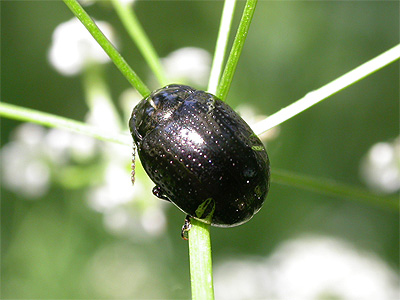 |
|
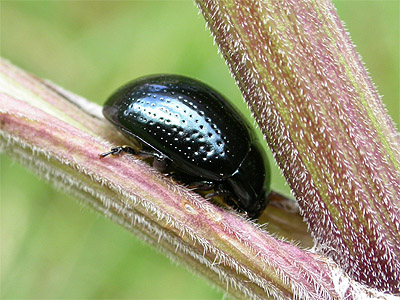 |
| |
|
|
| |
|
|
Chrysolina
polita (Linnaeus,
1758)  |
| A fairly
common species, Chrysolina polita is found
fairly regularly in the Eakring area on low-growing
vegetation, usually around areas of White dead-Nettle
(Lamium album). About 9mm in length, it's bright
colouration makes it quite conspicuous when sitting on
the upper surface of leaves on sunny days. Over-wintering
adults have been found several times under the loose bark
of felled Willow logs at Eakring Meadows NR. Uncommon at
Sherwood Forest and only recently discovered there for
the first time in 2009. C. polita seems to have
been quite widely recorded historically in
Nottinghamshire, with J.W. Carr quoting records from some
15 sites, ranging from Misson in the very north of the
county, through to Cotgrave south of Nottingham. |
| ...... |
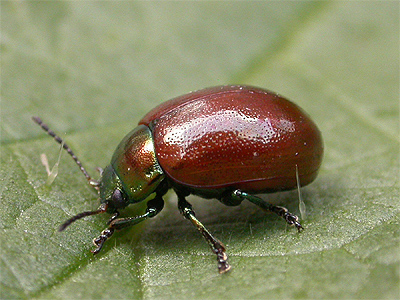 |
|
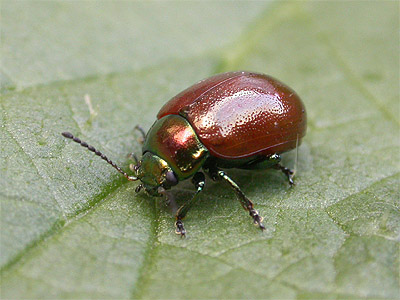 |
| |
|
|
| |
|
|
Chrysolina staphylaea (Linnaeus, 1758)  |
| Chrysolina
staphylaea is sometimes more commonly known as the
Brown Willow Beetle. This seems a fairly large Chrysolina
species, with the one pictured measuring 9.5mm. Our only
records are from Sherwood Forest CP in early June 2009
and at Cuckney Hay Wood in October 2012. Historical
records of C. staphylaea have come from Retford
district (Thornley and
Pegler) South
Leverton, Barrow Hills at Everton, Nottingham district (Ryles and Dodd) and Tollerton (Robinson 1914) |
| ...... |
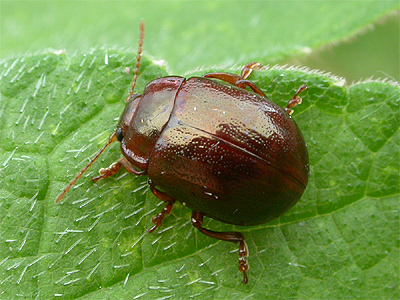 |
|
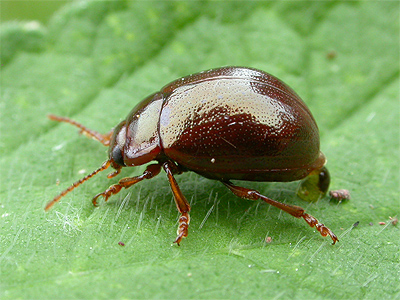 |
| |
|
|
| |
|
|
Chrysolina
banksi (Fabricius,
1775)  |
| This large
and conspicuous Chrysolina is currently not
known from anywhere in Nottinghamshire, but does have the
potential to occur here. During an invertebrate survey of
a former landfill site at Dartford, Kent in September
2012, singles or mating pairs were regularly found on
concrete walls around the site. Adults can be found on
their hostplants which are Black Horehound (Ballota
nigra) and Narrow-leaved Plantain (Plantago
lanceolata). |
| ...... |
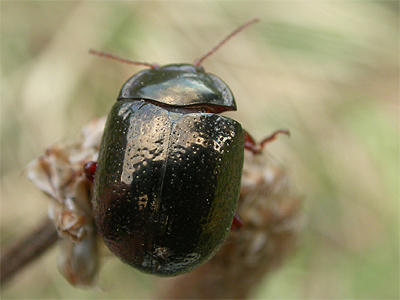 |
|
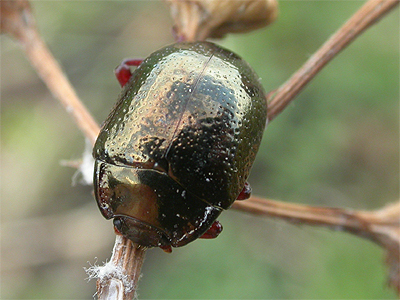 |


